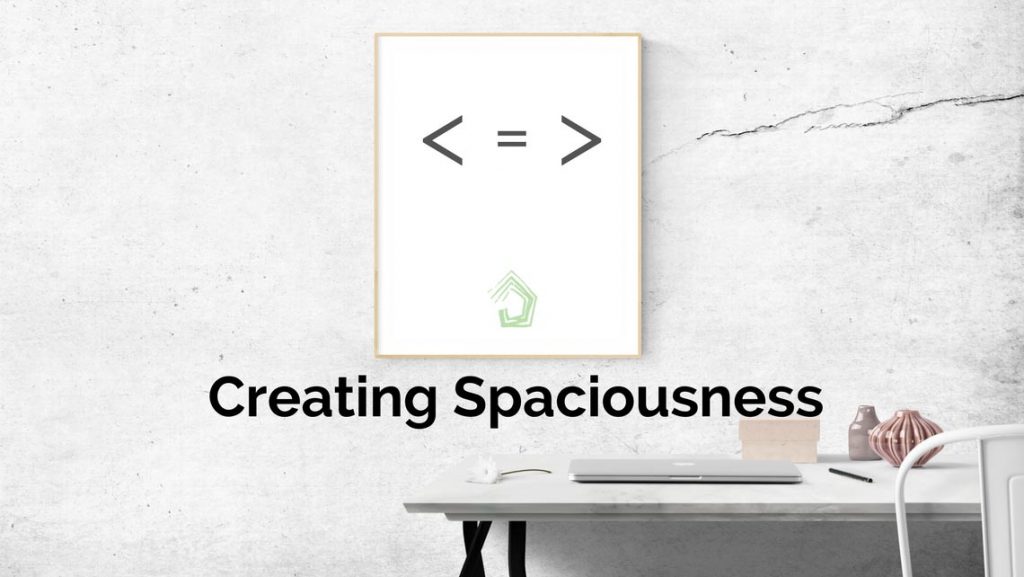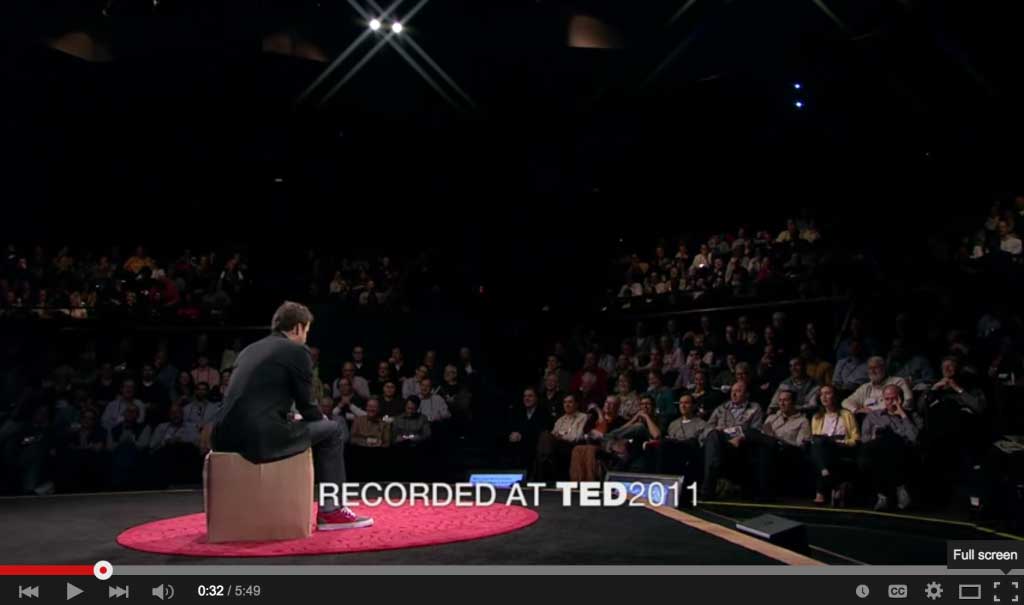
How can you create spaciousness in your home? There’s 3 ways to do this – even in the most compact of homes. Read on to see what they are.
One of my big design tips for creating your own well-designed home is to bring a feeling of spaciousness to the way you live.
Spaciousness in your home brings spaciousness to your mind … and no, not in an ’empty-head’ way … but instead bringing a sense of peace and calm to how you live, so that your home can become a place that you can you relax and restore.
So your mind has room for the stuff that’s really important.
Generally, when we think of spaciousness, we think of big spaces. Open horizons. Wide or long views.
However, the more projects I work on, and the more clients I help, experience is showing me that spaciousness can be achieved in compact homes as much as it can in large, sprawling ones.
CREATING SPACIOUSNESS – IN 3 WAYS
I have 3 main ways to achieve spaciousness in your design. These are to
- create strong indoor/outdoor connections to expand your interior
- use light to create volume and space
- provide great storage that helps you streamline your everyday activities
This notion of spaciousness is worth exploring generally, and there are some steps you can take first BEFORE you create your spacious, well-designed home.
SMALL SPACES AND TINY HOUSES
Recently, I attended Grand Designs Live in Sydney, and listened to a presentation from Sarah O’Neill from Small Spaces. Sarah shared her own journey of moving into a tiny apartment – a deliberate choice she made to achieve an affordable lifestyle in an urban location. Struggling to find suitable multi-functional furniture for her new home, and seeing a growing movement in this type of living choice, she decided to start her store in Redfern, Sydney – called Small Spaces – and now helps people who are on similar journeys.
If you follow the interwebs in regards to housing and design, you will have probably seen a growing presence of the Tiny House Movement. Originally started in the USA in the 1990s, motivated by a lack of access to affordable, sustainable housing, and people questioning the need for large and heavily mortgaged homes.
Following the trail as I explored more about this notion of living in a small space, I found this TED talk by Graham Hill on Small Spaces’ website. Have a look yourself (Click here or on the image to open a new window) – it’s just under 6 minutes and tells some staggering facts about the USA home owners growing their house size, and yet still not having enough room to put all their stuff. And that box. Or those boxes. You know – the ones you have and move from place to place … just incase you need whatever is inside them – even though you’ve forgotten what that is.
Did you know … Australia has the largest average home size in the world, and the area of our homes has grown from 115m2 in the 1950s to around 240m2 in 2011. Interestingly though, there’s less people living in these larger homes than there were back in the 1950s.
The thing I struggle with is that when I look at a lot of the info on the Tiny House Movement, or the TED talk for example, it’s usually an individual, or a couple, talking about their experience.
I’m always interested to see how families – especially those with a few kids – manage living in small spaces. It happens – particularly in European countries – where apartment living is much more the norm.
IS YOUR HOME JUST A CONTAINER FOR ALL YOUR STUFF?
I remember when my mum sold our family home after my brother and I had moved out, and she said she realised that the home had become a container for all her stuff.
That she had financially sustained this container for all these years, and was really questioning now how she wanted to spend her money instead. A smaller place, and more travel was the choice.
I have a client who is doing the same. Down-sizing to a more compact and efficient home … so it’s less maintenance for their full lives as working professionals with 3 young kids. It frees up money and time for experiences they want to share as a family, which is where their focus is for this next phase of their lives. They’re building close to great public open space and tapping into local infrastructure instead of investing in a big backyard. (I’m sharing the journey of them designing and building their new home – you can follow their project diary here)
It bears consideration. And I know that may be strange, or even hypocritical, coming from me, as our move to 77 acres in the Byron Bay Hinterland was mainly about giving our kids more space, more room. However, we did learn an important lesson on our journey here.
During renovating our third home (when we turned a 100m2 home into a 400m2 home), we lived in a self-contained 2 bedroom flat under the home of some very dear friends. Meanwhile, the home we were creating with our reno was the kind of home I thought we would one day seek to have ourselves.
However, what I realised in living in a smaller place was that we didn’t want or need the big 400m2 home … and the thing we really missed was a kid-friendly garden and space outside to run around in – as well as privacy, and peace and quiet in our connection to our environment. Byron Hinterland = sorted.
Veronica Morgan spoke about the fact that most people move because they run out of storage space (check my blog on that here).
From personal experience, I’ve found as our family has grown, so has our stuff. We have a lot of ‘stuff’. In fact, when we moved here, I counted over 50 boxes of ‘stuff’- most of which I hadn’t opened in 5 years. We had moved house 4 times in that period – not including moving it all in and out of storage a couple of times when we had our homes on the market. Each time, we moved all these boxes too. I know – ludicrous isn’t it?
STUFF AND ITS TRAPPINGS … OR THE TRAP IT CREATES
When my grandfather passed away over a decade ago, a few years after my grandmother, my father sorted out their home and couldn’t bear to part with their things. My grandmother made and carved mahogany furniture. She was quite prolific.
So my dad put it all in storage, until earlier this year when he sent it all to us. A whole removalist truck’s worth … that he had spent over $40,000 storing. Stuff he can’t bear to sell, is emotionally attached to, and doesn’t want to know what we choose to do with it (but apparently it’s our choice). And passed the emotional baggage of these belongings over to me.
Most of it is not to my taste. There are 2 or 3 pieces I appreciate aesthetically. But every piece has a story, and hence has its claws in me and I struggle to let it all go. Because it’s important that it goes to someone who will love it – it was made with love and care, and can’t just be wasted.
And so, our big garage, and our even bigger shed, is full of stuff. Stuff that exhausts me when I think about it. I walk past it everyday, and avert my eyes. Because it is overwhelming to think that it’s all there. That we should go through it and assess what we’re keeping. And then with what we’re not keeping, we need to determine how we’re going to get rid of it … sell it, pass it on, or chuck it.
I struggle with the fact that we, or someone else who gave it to us, paid for it once, and it’s perhaps worth something, and so I think we’ll sell it … I’ll have that garage sale, or put it on e-bay. So it goes on a pile. And that’s where it stays. 50 boxes worth.
Books. Furniture. Building materials. Kitchen equipment. Baby clothes. Kids’ toys (do they breed when we’re sleeping??). Baby clothes. Kids’ toys. So, so much baby clothing. Because mentally and physically I’ve shut down the idea of having another baby, but emotionally, I’m not so sure.
Best of intentions. Scarcity mindset. What if we need it? Perhaps I’ll hang onto it just incase. It’s such a waste to just get rid of it. We can’t waste it. Just incase.
And yet, I aspire to have this clutterless, spacious life – and to live that example for our kids too … where we live with an abundant mindset, and where the things around us are chosen with this framework that Sarah O’Neill talks about …
“Think about what matters to you. Make sure you live lightly and more mindfully. Keep possessions that you engage with regularly and let go of the rest.”
Interestingly, she spoke of having her own belongings in storage for 12 months after she moved to her apartment before she could let them go. So perhaps I can stop beating myself up about it a little.
BRING ON LIBERATION
So, these Christmas holidays, as a fresh start to 2015, I’m making a personal pledge.
Back the truck up.
Edit ruthlessly.
Create spaciousness.
Get back our garage and our shed. Declutter the house.
Get back the time I spend in cleaning it up and sorting it regularly. Get back a sense of peace of knowing where everything is when I need to find it. The sense of calm when everything has a place and everything is in its place.
And most importantly, get back the mental energy I expend in worrying about the fact we have all this stuff.
Just quietly, I’m a little scared (and perhaps a little overwhelmed) – but I think it will be liberating.
So before you decide to expand your home, or buy a bigger one to move to, take a look around at what your current home is being a container to. Do you need it all? And more importantly … is all that stuff really helping you lead the life you want to? What are you hanging on to that you could let go? Do you have a personal pledge you’d like to make? (I’d love to hear it).
Creating a well-designed home isn’t always about having more.
Sometimes it’s about optimising what you do have so it functions really well, is beautiful to be around and in, and supports you living your best life.
And sometimes, when you’re creating your beautiful home, less can be more. Less can be better.
The first season of the UA Podcast “Get it Right” shares more design tips on how to create spaciousness in 3 ways. You can listen to the episodes here:
Creating Spaciousness: Using Light
Creating Spaciousness: Using Volume

 With over 30 years industry experience, Amelia Lee founded Undercover Architect in 2014 as an award-winning online resource to help and teach you how to get it right when designing, building or renovating your home. You are the key to unlocking what’s possible for your home. Undercover Architect is your secret ally
With over 30 years industry experience, Amelia Lee founded Undercover Architect in 2014 as an award-winning online resource to help and teach you how to get it right when designing, building or renovating your home. You are the key to unlocking what’s possible for your home. Undercover Architect is your secret ally
Leave a Reply